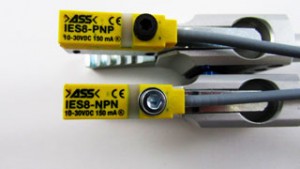HOW DOES A RPLG RELAY BOX WORK ?
In case you have several sensors on your tool and you want to send one signal to the robot if all sensors are being triggered, then you can use a RPLG. The RPLG provides the power to each sensor and collects each sensor’s input in series. If all sensors are “ON” the RPLG gives a “HIGH” output on terminal M. Terminal <1 switches to LOW when one input (sensor) is triggered This terminal is “HIGH” when ALL inputs (sensors) are “OFF”
NPN vs PNP: What’s the difference and why should anyone care? The “N” stands for “Negative” and the “P” stands for “Positive”. With respect to sensors, an NPN device is one that can switch the negative side of the circuit while a PNP device switches the positive side. All European machinery uses PNP style controls and sensors. Asian and some US machinery manufactures use NPN sensors. That’s why ASS provides all sensors in PNP and NPN versions. The wiring of the RPLG Relay Box is different, depending what type of sensor is being used, PNP or NPN . You can NOT mix NPN and PNP sensors with this box. The box does not convert PNP to NPN and vice verse
Can you use 2 wire sensors with a RPLG?
2 wire sensors or mechanical switches with so called “dry contacts” can be used with a RPLG. If you have 4 switches or less, we suggest using the KK1 box (Junction Box) which is less expensive because it doesn’t has relays which you do not need when you use mechanical switches.
Why should you use a RPLG?
- Prevent voltage drop especially if 6 or more sensors are being used
- LCDs in the RPLG show the status of each sensor
- LCD in the RPLG show the status of the signal to the robot (HIGH / LOW)
- Functions as a junction box
- Easier to trouble shoot
Click below for wiring instructions:
Wiring RPLG to PNP
Wiring RPLG to NPN

